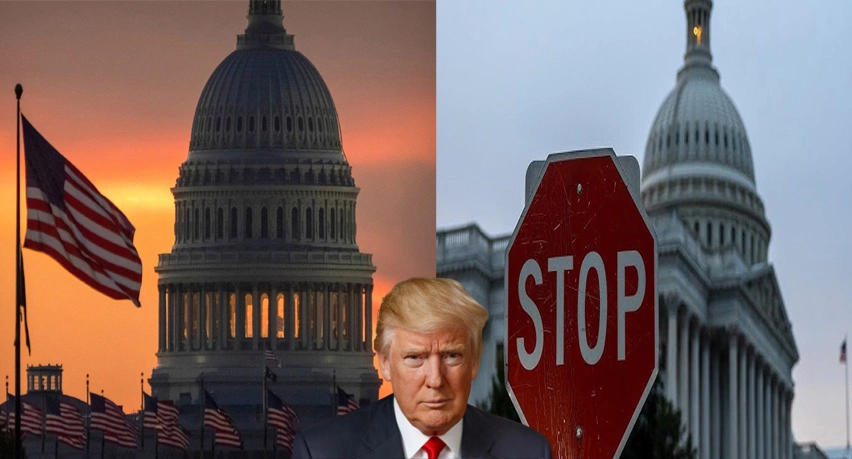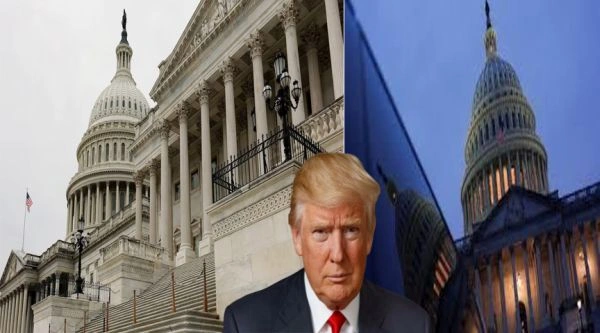A bitter standoff between Republican President.
Donald Trump and congressional Democrats has led to the 15th U.S. government shutdown since 1981, leaving federal agencies partially closed and millions of workers in limbo.
Here’s what each side wants and what it will take to reopen the government.
What Republicans Are Demanding
President Trump’s Republican Party, which controls both the House of Representatives and the Senate, has already celebrated major budget wins this year.
In July, lawmakers passed a sweeping package dubbed the “One Big Beautiful Bill.” The legislation:
Increased funding for defense and immigration enforcement
Cut spending on green energy programs and other Democratic priorities
Reduced Medicaid benefits for low-income and disabled Americans to help offset tax breaks for the wealthy
Republicans have also backed Trump’s attempts to claw back funding previously approved for foreign aid and public broadcasting—moves critics argue weaken Congress’s constitutional “power of the purse.”
At this point, Republicans say they will support a short-term funding resolution that keeps spending at current levels through November 21. They argue this would give both parties time to negotiate a longer-term budget deal.
What Democrats Are Pushing For
Though Democrats remain the minority in Congress, their votes are essential in the Senate. With 60 votes required to pass most legislation, Republicans must win over at least seven Democrats.
Democrats are using that leverage to demand:
Renewal of expanded healthcare subsidies under the Affordable Care Act (ACA).Permanent tax credits for middle-income families buying insurance
Provisions preventing Trump from blocking or withholding ACA funds
Rollback of ACA restrictions included in the “One Big Beautiful Bill”
If the subsidies expire, 24 million Americans could face steep premium increases, according to the Kaiser Family Foundation. The impact would be felt most in Republican-led states that refused to expand Medicaid.
Democrats argue their plan would extend healthcare to 7 million more Americans by 2035, though the Congressional Budget Office estimates it would add $662 billion in government spending over a decade.
Republicans counter that healthcare fixes should be debated separately—and accuse Democrats of trying to extend subsidies to undocumented immigrants, a charge Democrats deny.
Fallout of the Shutdown
With no budget deal, the shutdown has forced U.S. federal agencies to halt all non-essential services:
Essential workers (law enforcement, military, TSA agents, air traffic controllers) continue on duty but will not be paid until the shutdown ends.
Non-essential staff are furloughed, slashing government capacity.
Programs like Social Security, Medicare, and veterans’ healthcare remain intact, as their funding is mandatory.
However, the shutdown is already disrupting:
The National Institutes of Health (NIH), which has stopped enrolling new patients in clinical trials
The Department of Education, where 87% of staff face furloughs
The National Park Service, with two-thirds of workers sent home, risking damage to protected sites
Political Blame Game
Republicans insist the shutdown is purely political. Senate Majority Leader John Thune accused Democrats of blocking a funding measure they had supported under past presidents.
“Democrats may have chosen to shut down the government tonight, but we can reopen it tomorrow,” Thune told reporters. “All it takes is a handful of Democrats to join Republicans on this clean, nonpartisan bill.”
Democrats, meanwhile, argue that Trump is using federal workers as leverage to force concessions on healthcare and immigration.
Analysts Warn of Prolonged Crisis
Experts caution that this shutdown could drag on longer than past closures, given the country’s polarized climate.
Robert Pape, a political scientist at the University of Chicago, noted that both parties are under pressure from hardline supporters unwilling to compromise.
“The rules of politics are changing. Each side fears betraying millions of aggressive supporters, making it far harder to strike a deal,” Pape said.
What Happens Next?
If the standoff continues for weeks, the shutdown could:Delay paychecks for hundreds of thousands of federal workers.Cause economic strain in communities reliant on government jobsStall critical research and education programs
Readmore Punjab Green E-Taxi Program CM Registration 2025 Online Portal
For now, the government remains in limbo—caught between Republican calls for fiscal discipline and Democratic demands for healthcare protections.
As the latest U.S. government shutdown begins, the consequences are spreading across national parks, financial markets, and federal agencies. The standoff between President Donald Trump and Democrats in Congress is already creating ripple effects at home and abroad.
National Parks Face Risk of Long-Term Damage
During the 2018-2019 shutdown, national parks were left open but largely unstaffed, leading to widespread vandalism and environmental damage. At Joshua Tree National Park, cars cut new roads into protected wilderness, trees were destroyed, and graffiti scarred natural landmarks.
Curt Sauer, the park’s former superintendent, warned at the time that it could take 200 to 300 years for Joshua Tree to fully recover from the 35-day shutdown.
This time, parks are set to remain open again but with reduced staffing, raising fears of similar destruction without adequate protection or maintenance.
Global Markets React Cautiously
World financial markets showed mixed reactions to the shutdown. While most analysts expect the overall impact to be limited, uncertainty is weighing on trading floors.
S&P 500 and Dow futures dipped 0.6%
Nasdaq Composite rose slightly by 0.3% to 22,660.01
Germany’s DAX slipped 0.2% to 23,916.90
France’s CAC 40 fell 0.2% to 7,907.99
UK’s FTSE 100 gained 0.7% to 9,416.30
Meanwhile, oil prices edged lower with U.S. crude at $62.16 per barrel and Brent crude at $65.80 per barrel. The dollar weakened against the yen, while the euro made modest gains.
Political Controversy Deepens
The shutdown has sparked heated accusations across Washington.
The Department of Housing and Urban Development (HUD) posted a banner blaming the crisis on the “Radical Left.” Advocacy group Public Citizen filed a complaint, calling it a violation of the Hatch Act, which prohibits partisan political activity by federal employees.
Bush, criticized Trump’s threats to use the shutdown to fire protected civil service workers, calling it a “strong-arm tactic.”
Democrats, meanwhile, argue Republicans are deliberately weaponizing the shutdown. Senate Majority Leader Chuck Schumer declared:
“The Republican shutdown has just begun because Republicans wouldn’t protect America’s healthcare. We are going to keep fighting for the American people.”
Republicans counter that Democrats are blocking a clean funding bill for political gain.
Environmental and Safety Concerns
Beyond politics, experts warn of real-world dangers:
EPA inspections halted – Former EPA official Marc Boom said the pause in oversight raises the risk of chemical accidents, leaving communities more vulnerable.
Pollution may rise – Jeremy Symons, an environmental adviser, cautioned that companies could exploit the shutdown to dump toxic emissions unchecked, noting a 2018-19 study where coal plants increased pollution during EPA furloughs.
Public reporting stalled – Hotlines for reporting water contamination and environmental violations are now closed, leaving communities without critical protections.
Impact on Economic Data and Workers
Roughly 750,000 federal workers are expected to be furloughed, while others may face permanent layoffs under Trump’s push to shrink government agencies.
This has immediate implications:Key economic data reports—such as Friday’s crucial U.S. jobs report—may be delayed or suspended.
Financial markets could become more volatile without updated economic indicators.Essential services like Social Security and Medicare will continue, but many agencies risk long-term downsizing.
Economist Stephen Innes summed up the investor mood:
Markets hate uncertainty more than bad news. Without fresh data, this shutdown could get noisier.”
The Bigger Picture.The shutdown, one of the most disruptive in decades, underscores how polarized U.S. politics has become. Democrats accuse Republicans of choosing “chaos over governance,” while Trump insists the stalemate is necessary to rein in spending and push healthcare reforms.
For now, Americans face national park closures, environmental risks, economic uncertainty, and delayed federal services—with no clear timeline for resolution.


